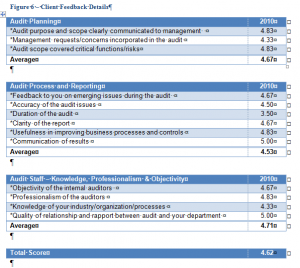Building an effective audit client satisfaction survey.
Anyone providing products or services to customers should want to know what customers think about the product/services. Internal Auditors typically solicit feedback through client satisfaction surveys. There are a variety of ways to solicit opinions including live interviews and questionnaires. Successful questionnaires will help audit functions determine how well they are achieving goals and objectives. Many auditor simply copy surveys from other departments. I believe auditors must create surveys specifically for their operating environment. Successful surveys must consider the Stakeholders, the Questions and the Results.
Stakeholders
Internal Auditing functions are independent, objective functions charged with evaluating control environments to provide stakeholders with reasonable assurance that risks are appropriately managed. Therefore, surveys must address the concerns of stakeholders.
There are 3 things that must occur in order to determine your stakeholders satisfaction level.
1. Identify the stakeholders
2. To determine their expectations
3. Design relevant questions to assess performance to expectations
Questions
Theoretically, you want to ask audit clients everything. However, this is not practical. Good internal audit satisfaction surveys should
1. Use neutral questions,
2. Be an appropriate length and
3. Have a non biased rating scale.
Biased questions lead to biased answers. Consider the Verizon “Easy Choice” commercial (video below) in which customers are shown graphs of 4g LTE coverae and asked which would they prefer. The graphs are obviously skewed to show Verizon with the best LTE 4g coverage. As a result, the customers choose Verizon. However, the commercial fails to mention that T Mobile’s 4g coverage is based on the HSPA+ network and is just as fast as the LTE network.
Clients should be able to complete surveys in no more than 10 minutes. Ideally, the survey should take only a few minutes. The longer the survey, the less likely your clients are to take the time to complete them.
There is significant relevancy in your rating scale. The scale must allow for a neutral response, therefore, an odd number of responses is ideal. Consider the following rating scale if asked
How Satisfied You Are With the Level of Service Received
- Very Satisfied
- Satisfied
- Neither Satisfied no Dissatisfied
- Dissatisfied
- Very Dissatisfied
Eliminating the middle/neutral choice forces survey respondents to provide either a negative or positive answer without room for a neutral answer.
Results
Once received, survey results must be appropriately analyzed to identify what is being done well, what is perceived as an average service delivery and what practices definitely need to be changed. It is also important to report survey result to stakeholders. Using a scoring methodology allows you to compare scores over a time horizon. For example, an answer of “Very Satisfied” to your survey could be worth 5 points, “Satisfied” 4, etc. Then you can determine a total score as well as a score by question this year and compared to prior years. The screen print below is an example of actual survey results for 2010.
PERSPECTIVE
Prior to designing my survey, I asked my stakeholders about their expectations. A majority of them said the following:
- Tell us something we don’t know already
- Try to understand our business
- Don’t surprise us (keep us informed)
Therefore, I constructed the following survey questions with a 5 point rating scale ranging from Very Dissatisfied to Very Satisfied to determine if we meet these expectations:
*Audit purpose and scope clearly communicated to management
*Management requests/concerns incorporated in the audit
*Audit scope covered critical functions/risks
*Feedback to you on emerging issues during the audit
*Accuracy of the audit issues
*Duration of the audit
*Clarity of the report
*Usefulness in improving business processes and controls
*Communication of results
*Objectivity of the internal auditors
*Professionalism of the auditors
*Knowledge of your industry/organization/processes
*Quality of relationship and rapport between audit and your department
[divider]


